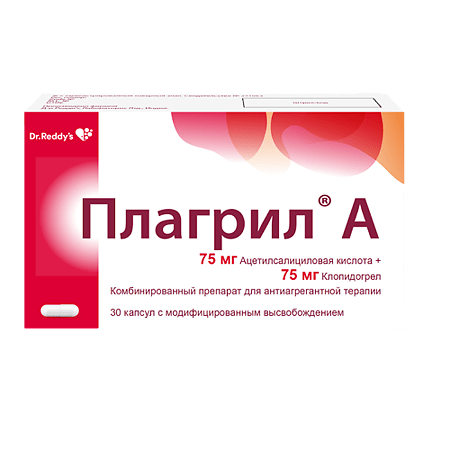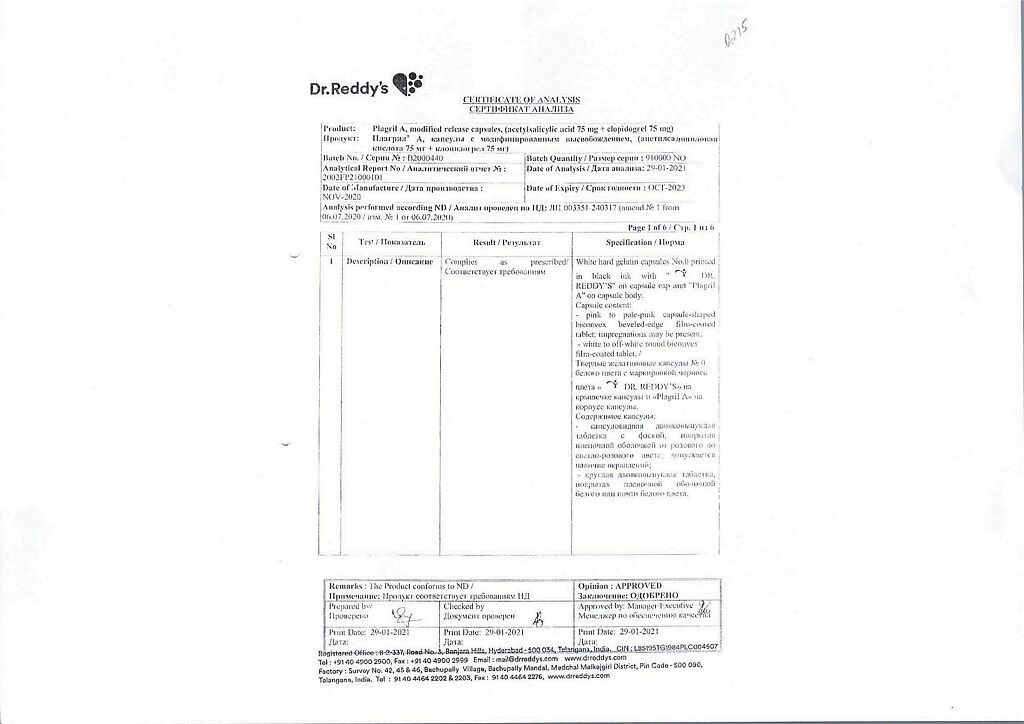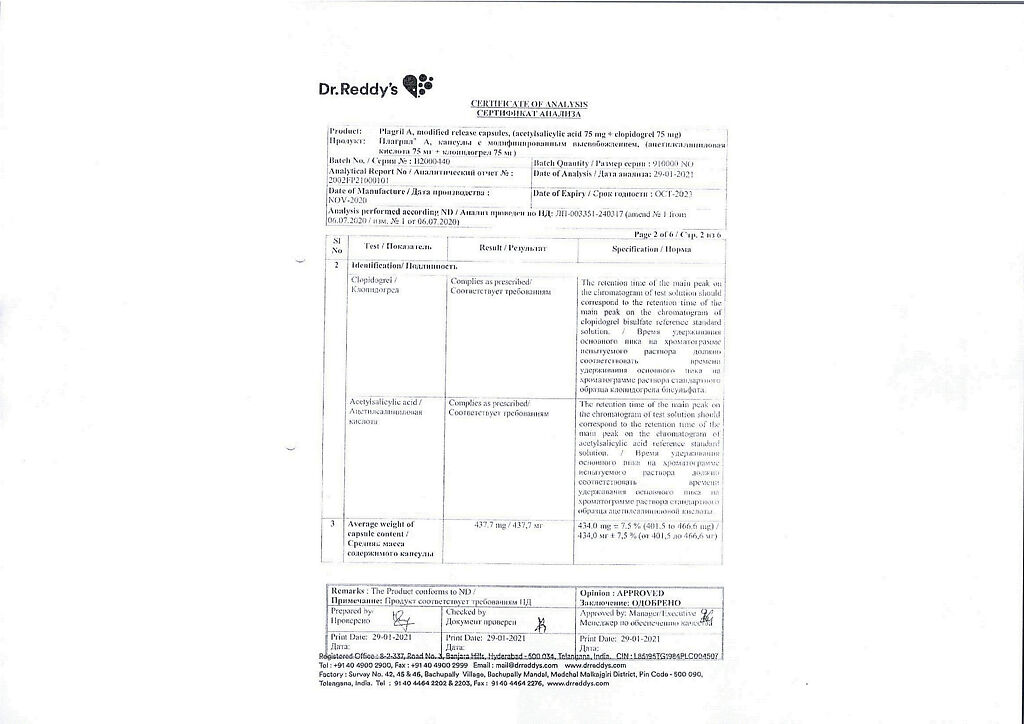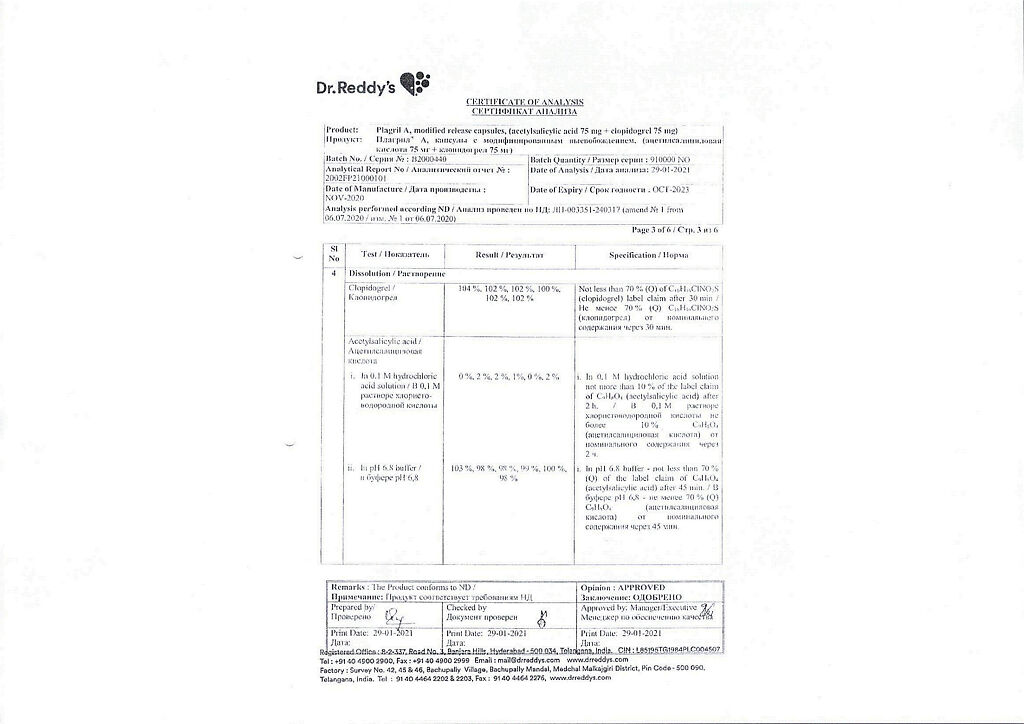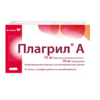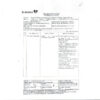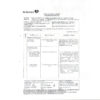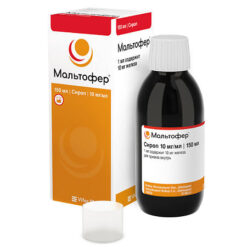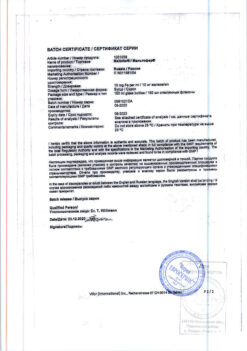No products in the cart.
Plagril A, 75 mg+75 mg 30 pcs
€26.18 €22.69
Description
Pharmacodynamics
Clopidogrel
.Clopidogrel (more precisely, its active metabolite) irreversibly binds to platelet ADP receptors and selectively inhibits the binding of ADP to platelet ADP receptors and the subsequent activation of GPIIb/IIIa complex under the action of ADP, thus suppressing ADP-induced platelet aggregation. Clopidogrel also inhibits platelet aggregation caused by other agonists by blocking the increase in platelet activity by released adenosine diphosphate. Due to the irreversible binding of clopidogrel with platelet ADP-receptors, platelets remain immune to ADP stimulation for the rest of their life, and the restoration of normal platelet function occurs at a rate corresponding to the rate of platelet renewal.
When clopidogrel is taken daily at a dose of 75 mg, there is a significant suppression of ADP-induced platelet aggregation from the first day of administration, which gradually increases over 3-7 days and then reaches a constant level (when the equilibrium state is reached). In the equilibrium state, platelet aggregation is suppressed by an average of 40-60%. After stopping clopidogrel administration platelet aggregation and bleeding time gradually return to the initial level
on average within 5 days.
Acetylsalicylic acid (ASA)
ASA suppresses platelet aggregation through irreversible inhibition of cyclooxygenase-1 (COX-1), thereby reducing the formation of thromboxane A2, which is an inducer of platelet aggregation and vasoconstriction. This effect persists throughout the life of platelets.
ASA does not change the inhibitory effect of clopidogrel on ADP-induced platelet aggregation, while clopidogrel increases the effect of acetylsalicylic acid on collagen-induced platelet aggregation.
Both active substances are able to prevent the development of atherothrombosis in any localization of atherosclerotic vascular lesions, in particular in lesions of the cerebral, coronary or peripheral arteries.
Pharmacokinetics
Assimilation
Clopidogrel
.
Clopidogrel is rapidly absorbed in the intestine at a single and course oral dose of 75 mg per day. Mean maximum plasma concentrations of unchanged clopidogrel (about 2.2-2.5 ng/ml after oral administration of a single dose of
75 mg) are reached approximately 45 minutes after its single administration.
According to the excretion of clopidogrel metabolites by the kidneys its absorption is approximately 50%.
Acetylsalicylic acid
After absorption ASK undergoes hydrolysis to form salicylic acid, the maximum concentrations of which in blood plasma are reached one hour after oral administration. Due to rapid hydrolysis in 1.5-3 hours after oral administration ASK is practically not detected in blood plasma.
Distribution
Clopidogrel
In vitro, clopidogrel and its major circulating inactive metabolite reversibly bind to plasma proteins (by 98% and 94%, respectively) and this binding in vitro is unsaturated up to a concentration of 100 mg/L.
Acetylsalicylic acid
ASK weakly binds to plasma proteins and has a small volume of distribution (10 liters). Its metabolite, salicylic acid, binds well to plasma proteins, but its binding to plasma proteins depends on its plasma concentration
(non-linear relationship).
At low concentrations (< 100 µg/ml) about 90% of salicylic acid binds to plasma albumin. Salicylic acid is well distributed in tissues and body fluids, including the central nervous system, breast milk and fetal tissues.
Metabolism
Clopidogrel
Clopidogrel is rapidly metabolized in the liver. In vitro and in vivo, clopidogrel is metabolized via two metabolic pathways: the first pathway is metabolized by esterases, which leads to hydrolysis to form the inactive metabolite ̶ carboxylic acid derivative (accounting for 85% of the metabolites circulating in the systemic blood stream); the second pathway is carried out by several cytochrome P450 system isozymes. At first, clopidogrel is metabolized to 2-oxo-clopidogrel, which is an intermediate metabolite.
Subsequent metabolism of 2-oxo-clopidogrel leads to the formation of the active metabolite of clopidogrel – thiol derivative of clopidogrel. In vitro, this metabolic pathway is metabolized by the CYP2C19, CYP1A2, CYP3A4, and CYP2B6 isoenzymes. The active thiol metabolite of clopidogrel, which was isolated in in vitro studies, rapidly and irreversibly binds to platelet receptors, inhibiting platelet aggregation.
After a loading dose of clopidogrel 300 mg, the maximum concentration (Cmax) of the active metabolite is 2 times higher than that after 4 days of a maintenance dose of clopidogrel 75 mg, while its Cmax is reached approximately 30-60 minutes after clopidogrel administration.
Acetylsalicylic Acid
ASA when taken in combination with clopidogrel is rapidly hydrolyzed in plasma to salicylic acid with a half-life of 0.3 to 0.4 hours for ASA 75-100 mg doses. Salicylic acid mainly undergoes conjugation in the liver to form salicylic acid, phenolic glucuronide and acyl glucuronide, as well as a large number of minor metabolites.
Elevation
Clopidogrel
Within 120 hours of human oral intake of 14C-labeled clopidogrel, approximately 50% of the radioactivity is excreted by the kidneys and approximately 46% of the radioactivity is excreted through the intestine. After a single oral dose of 75 mg, the elimination half-life of clopidogrel is approximately 6 hours. After a single and a course of clopidogrel administration, the half-life of the main circulating inactive metabolite in blood is 8 hours.
Acetylsalicylic Acid
The half-life of salicylic acid from blood plasma is about 2 hours. The metabolism of salicylate is saturable, and total clearance is reduced at higher serum concentrations due to the limited ability of the liver to form salicyluric acid and phenolic glucuronide.
After taking toxic doses of ASA (10-20 g), the plasma elimination half-life may increase up to 20 hours. At high doses of ASA, the elimination of salicylic acid corresponds to zero-order kinetics (that is, the elimination rate depends on the plasma concentration) with a half-life of 6 hours or longer.
Renal excretion of the unchanged active substance depends on urine pH. When pH exceeds 6.5 the renal clearance of free salicylate increases
from <5% to >80%. After administration of therapeutic doses, approximately 10% of the ingested dose as salicylic acid, 75% of the ingested dose ̶ as salicyluric acid, 10% of the ingested dose ̶ as phenolic glucuronides, and 5% of the ingested dose ̶ as acyl glucuronides are detected in the urine.
Pharmacogenetics
Several polymorphic isoenzymes of the cytochrome P450 system are involved in the activation of clopidogrel. The CYP2C19 isoenzyme is involved in the formation of both the active metabolite and the intermediate metabolite ̶ 2-oxo-clopidogrel. Pharmacokinetics and antiplatelet effects of the active metabolite clopidogrel studied by in vivo platelet aggregation differ depending on the genotype of CYP2C19 isoenzyme.
The CYP2C19*1 gene allele is responsible for normally functioning metabolism, whereas the CYP2C19*2 and CYP2C19*3 isoenzyme gene alleles are responsible for reduced metabolism. These alleles are responsible for reduced metabolism in approximately 85% of Caucasoid races and 99% of Mongoloid races.
Other alleles responsible for reduced metabolism are represented by CYP2C19*4, *5, *6, *7, and *8 isoenzymes, but they are rare in the general population. Pharmacogenetic testing can identify a genotype with variability in CYP2C19 isoenzyme activity. Genetic variants of other enzymes of P450 system with influence on formation of active clopidogrel metabolites are also possible.
Individual patient groups
Elderly patients. No differences in platelet aggregation and bleeding time were obtained in elderly volunteers (over 75 years old) when compared with younger volunteers. No dose adjustment is required for elderly patients.
Children and adolescents.
No data available.
Renal dysfunction. After repeated administration of clopidogrel at a dose of 75 mg/day in patients with severe renal impairment (creatinine clearance (CK) of 5 to
15 ml/min) inhibition of ADP-induced platelet aggregation was lower (25%) compared to that in healthy volunteers, but prolongation of bleeding time was similar to that in healthy volunteers receiving clopidogrel at a dose of 75 mg/day.
Impaired liver function. After daily use of clopidogrel in daily dose of 75 mg for 10 days in patients with severe hepatic impairment (Chile-Pugh grades ̶ A and B less than 9 points) inhibition of ADP-induced platelet aggregation was similar to that in healthy volunteers. Mean bleeding time was comparable in both groups.
Ethnicity. The prevalence of CYP2C19 isoenzyme gene alleles responsible for intermediate and reduced metabolism is different between ethnic groups. There are limited literature data on their prevalence among representatives of the Mongoloid race to assess the clinical significance of the impact of CYP2C19 isoenzyme genotypes on clinical outcomes.
The pharmacokinetics and metabolism of both active substances of Plagril® A exclude clinically significant pharmacokinetic interactions.
Indications
Indications
The combination drug Plagril® A is indicated for use in patients who are already receiving both clopidogrel and acetylsalicylic acid (see section “Method of administration and dosage”).
Prevention of atherothrombotic complications
In adult patients with acute coronary syndrome:
– without ST segment elevation (unstable angina or non-Q wave myocardial infarction), including patients who underwent stenting during percutaneous coronary intervention;
– with ST segment elevation (acute myocardial infarction) with drug treatment and the possibility of thrombolysis.
Prevention of atherothrombotic and thromboembolic complications, including stroke, in atrial fibrillation (atrial fibrillation)
Adult patients with atrial fibrillation (atrial fibrillation) who have at least one risk factor for vascular complications cannot take indirect anticoagulants and have a low risk of bleeding.
Pharmacological effect
Pharmacological effect
Pharmacodynamics
Clopidogrel
Clopidogrel (more precisely, its active metabolite) irreversibly binds to platelet ADP receptors and selectively inhibits the binding of ADP to platelet ADP receptors and the subsequent activation of the GPIIb/IIIa complex under the influence of ADP, thereby suppressing ADP-induced platelet aggregation. Clopidogrel also inhibits platelet aggregation induced by other agonists by blocking the increase in platelet activity by released adenosine diphosphate. Due to the irreversibility of clopidogrel’s binding to platelet ADP receptors, platelets remain resistant to ADP stimulation for the remainder of their life, and restoration of normal platelet function occurs at a rate corresponding to the rate of platelet turnover.
When taking clopidogrel daily at a dose of 75 mg, from the first day of administration, a significant suppression of ADP-induced platelet aggregation is observed, which gradually increases over 3-7 days and then reaches a constant level (when an equilibrium state is reached). At steady state, platelet aggregation is suppressed by an average of 40–60%. After stopping clopidogrel, platelet aggregation and bleeding time gradually return to baseline
on average within 5 days.
Acetylsalicylic acid (ASA)
ASA suppresses platelet aggregation due to irreversible inhibition of cyclooxygenase-1 (COX-1), as a result of which the formation of thromboxane A2, which is an inducer of platelet aggregation and vasoconstriction, is reduced. This effect persists throughout the life of platelets.
ASA does not change the inhibitory effect of clopidogrel on ADP-induced platelet aggregation, while clopidogrel enhances the effect of acetylsalicylic acid on collagen-induced platelet aggregation.
Both active substances are able to prevent the development of atherothrombosis in any localization of atherosclerotic vascular lesions, in particular in lesions of the cerebral, coronary or peripheral arteries.
Pharmacokinetics
Suction
Clopidogrel
With a single or course oral dose of 75 mg per day, clopidogrel is quickly absorbed in the intestine. Average maximum concentrations of unchanged clopidogrel in blood plasma (about 2.2-2.5 ng/ml after oral administration of a single dose
75 mg) are achieved approximately 45 minutes after a single dose.
According to the excretion of clopidogrel metabolites by the kidneys, its absorption is approximately 50%.
Acetylsalicylic acid
After absorption, ASA undergoes hydrolysis to form salicylic acid, the maximum concentrations of which in the blood plasma are reached an hour after ingestion of ASA. Due to rapid hydrolysis, 1.5-3 hours after oral administration, ASA is practically not detected in the blood plasma.
Distribution
Clopidogrel
In vitro, clopidogrel and its main inactive metabolite circulating in the blood are reversibly bound to plasma proteins (98% and 94%, respectively) and this binding in vitro is unsaturated up to a concentration of 100 mg/l.
Acetylsalicylic acid
ASA weakly binds to proteins in blood plasma and has a small volume of distribution (10 l). Its metabolite, salicylic acid, binds well to plasma proteins, but its binding to plasma proteins depends on its concentration in the blood plasma
(non-linear connection).
At low concentrations (<100 mcg/ml), about 90% of salicylic acid is bound to plasma albumin. Salicylic acid is well distributed in body tissues and fluids, including the central nervous system, breast milk and fetal tissue.MetabolismClopidogrelClopidogrel is rapidly metabolized in the liver. In vitro and in vivo, clopidogrel is metabolized along two metabolic pathways: the first metabolic pathway is carried out using esterases, which leads to hydrolysis with the formation of an inactive metabolite – a carboxylic acid derivative (accounts for 85% of the metabolites circulating in the systemic circulation); the second pathway is carried out using several isoenzymes of the cytochrome P450 system. In this case, clopidogrel is first metabolized to 2-oxo-clopidogrel, which is an intermediate metabolite.Subsequent metabolism of 2-oxo-clopidogrel leads to the formation of the active metabolite of clopidogrel, the thiol derivative of clopidogrel. In vitro, this metabolic pathway occurs through the isoenzymes CYP2C19, CYP1A2, CYP3A4 and CYP2B6. The active thiol metabolite of clopidogrel, which was isolated in in vitro studies, binds rapidly and irreversibly to platelet receptors, inhibiting platelet aggregation.After taking a loading dose of clopidogrel 300 mg, the maximum concentration (Cmax) of the active metabolite is 2 times higher than that after taking a maintenance dose of clopidogrel 75 mg for 4 days, while its Cmax is reached approximately 30-60 minutes after taking clopidogrel.Acetylsalicylic acidASA, when taken in combination with clopidogrel, is rapidly hydrolyzed in the blood plasma to salicylic acid with a half-life of 0.3 – 0.4 hours for ASA doses of 75-100 mg. Salicylic acid is primarily conjugated in the liver to form salicyluric acid, phenolic glucuronide and acyl glucuronide, as well as a large number of minor metabolites.RemovalClopidogrelWithin 120 hours after human ingestion of 14C-labeled clopidogrel, approximately 50% of the radioactivity is excreted by the kidneys and approximately 46% of the radioactivity is excreted through the intestines. After a single oral dose of 75 mg, the half-life of clopidogrel is approximately 6 hours. After a single and course dose of clopidogrel, the half-life of the main inactive metabolite circulating in the blood is 8 hours.Acetylsalicylic acidThe half-life of salicylic acid from blood plasma is about 2 hours. The metabolism of salicylate is saturable and total clearance is reduced at higher serum concentrations due to the limited ability of the liver to form salicyluric acid and phenolic glucuronide.After taking toxic doses of ASA (10-20 g), the plasma half-life can increase to 20 hours. At high doses of ASA, the elimination of salicylic acid follows zero-order kinetics (that is, the rate of elimination depends on the plasma concentration) with a half-life of 6 hours or more.
Renal excretion of unchanged active substance depends on urine pH. When the pH increases above 6.5, the renal clearance of free salicylate increases
from 80%. After taking therapeutic doses, approximately 10% of the dose is found in the urine as salicylic acid, 75% of the dose as salicyluric acid, 10% of the dose as phenolic glucuronides and 5% of the dose as acyl glucuronides.
Pharmacogenetics
Several polymorphic isoenzymes of the cytochrome P450 system are involved in the activation of clopidogrel. The CYP2C19 isoenzyme is involved in the formation of both the active metabolite and the intermediate metabolite ̶ 2-oxo-clopidogrel. The pharmacokinetics and antiplatelet effects of the active metabolite of clopidogrel, studied by platelet aggregation in vivo, differ depending on the genotype of the CYP2C19 isoenzyme.
The allele of the CYP2C19*1 gene is responsible for normally functioning metabolism, while the alleles of the CYP2C19*2 isoenzyme gene and the CYP2C19*3 isoenzyme are responsible for reduced metabolism. These alleles are responsible for decreased metabolism in approximately 85% of Caucasians and 99% of Mongoloids.
Other alleles that cause reduced metabolism are the CYP2C19 isoenzymes*4, *5, *6, *7 and *8, but these are rare in the general population. Pharmacogenetic testing allows one to determine the genotype with variability in the activity of the CYP2C19 isoenzyme. Genetic variants of other enzymes of the P450 system are also possible with an effect on the formation of active metabolites of clopidogrel.
Selected patient groups
Elderly patients. In elderly volunteers (over 75 years of age), when compared with young volunteers, there were no differences in platelet aggregation and bleeding time. No dose adjustment is required for elderly patients.
Children and teenagers.
No data available.
Renal dysfunction. After repeated doses of clopidogrel at a dose of 75 mg/day in patients with severe renal impairment (creatinine clearance (CC) from 5 to
15 ml/min) inhibition of ADP-induced platelet aggregation was lower (25%) compared with that in healthy volunteers, but the prolongation of bleeding time was similar to that in healthy volunteers receiving clopidogrel at a dose of 75 mg/day.
Liver dysfunction. After taking clopidogrel daily for 10 days at a daily dose of 75 mg in patients with severe liver dysfunction (classes
A and B = less than 9 Child-Pugh scores) inhibition of ADP-induced platelet aggregation is similar to that in healthy volunteers. The mean bleeding time was comparable in both groups.
Ethnicity. The prevalence of alleles of the CYP2C19 isoenzyme genes responsible for intermediate and reduced metabolism differs among representatives of different ethnic groups. There is limited literature data on their prevalence among representatives of the Mongoloid race to assess the clinical significance of the influence of CYP2C19 isoenzyme genotypes on clinical outcomes.
Features of the pharmacokinetics and metabolism of both active substances of the drug Plagril® A exclude clinically significant pharmacokinetic interactions.
Special instructions
Special instructions
Bleeding and blood disorders
Due to the risk of bleeding and blood disorders (see section “Side Effects”), if clinical symptoms suspicious for bleeding appear during treatment, you should urgently do a general clinical blood test, determine the activated partial thromboplastin time (aPTT), platelet count, indicators of platelet functional activity and conduct other necessary studies.
Due to the presence of two antiplatelet agents in the composition of Plagril® A, it should be used with caution in patients at increased risk of bleeding due to trauma, surgery or other pathological conditions, as well as in patients receiving NSAIDs (including COX-2 inhibitors), heparin, glycoprotein IIb/IIIa inhibitors, SSRIs and thrombolytic agents. Patients should be closely monitored for signs of bleeding, including occult bleeding, especially during the first weeks of treatment and/or after invasive cardiac procedures/surgery.
The simultaneous use of Plagril® A with indirect anticoagulants is not recommended, as this may increase the intensity of bleeding (see section “Interaction with other drugs”), therefore, with the exception of special rare clinical situations (such as the presence of a floating thrombus in the left ventricle, stenting in patients with atrial fibrillation or other indications for the use of indirect anticoagulants), the combined use of Plagril® A and warfarin is not recommended.
If the patient is undergoing a planned surgical intervention and there is no need to achieve an antithrombotic effect, then Plagril® A should be discontinued 7 days before surgery. Plagril® A increases bleeding time and should be used with caution in patients with diseases and conditions that predispose to the development of bleeding, especially bleeding from the gastrointestinal tract and intraocular hemorrhages.
Patients should be warned that when taking Plagril® A, bleeding may take longer to stop than usual, and that if they develop any unusual bleeding in location or duration, they should report this to their doctor. Before any upcoming surgery and before starting any new drug, patients should tell their doctor (including their dentist) about their drug treatment
Plagril® A.
Thrombotic thrombocytopenic purpura
Very rarely, after the use of clopidogrel, cases of thrombotic thrombocytopenic purpura (TTP), which is characterized by thrombocytopenia and microangiopathic hemolytic anemia, accompanied by neurological disorders, renal dysfunction and fever, have been reported. TTP is a potentially life-threatening condition that requires immediate treatment, including plasmapheresis.
Acquired hemophilia
Cases of acquired hemophilia have been reported when taking clopidogrel. With a confirmed isolated increase in activated partial thromboplastin time (aPTT), with or without bleeding, the development of acquired hemophilia should be considered. Patients with a confirmed diagnosis of acquired hemophilia should be observed and treated by a specialist in this disease and stop taking clopidogrel.
Cross allergic and/or hematological reactions between thienopyridines
Patients should be assessed for previous allergic and/or hematological reactions to other thienopyridines (such as ticlopidine, prasugrel), as cross-allergic and/or hematological reactions between thienopyridines have been reported (see section “Side Effects”).
Thienopyridines may cause moderate to severe allergic reactions (such as rash, angioedema) or hematological reactions (such as thrombocytopenia and neutropenia). Patients who have previously experienced allergic and/or hematological reactions to one of the thienopyridine drugs may have an increased risk of developing similar reactions to another thienopyridine drug. Monitoring for cross-allergic and/or hematological reactions is recommended.
Recent ischemic stroke
It has been shown that in patients with a recent history of ischemic transient cerebrovascular accident or stroke, who are at increased risk of developing an ischemic complication, the combination of acetylsalicylic acid and clopidogrel increases the likelihood of major bleeding. Therefore, the use of Plagril® A in such patients should be carried out with caution and only in case of proven clinical benefit from its use.
Effect on the gastrointestinal tract
Plagril® A should be used with caution in patients with a history of gastric or duodenal ulcers or gastrointestinal bleeding or in patients with even mild upper gastrointestinal symptoms that may be manifestations of gastric ulcers that can lead to gastric bleeding.
During treatment with Plagril® A, upper gastrointestinal symptoms such as gastralgia, heartburn, nausea, vomiting and gastrointestinal bleeding may occur at any time. Despite the fact that minor side effects from the gastrointestinal tract, such as dyspeptic disorders, are common during treatment with Plagril® A, the doctor should always rule out ulceration of the gastrointestinal mucosa and bleeding in these cases, even in the absence of a history of gastrointestinal pathology.
Functional activity of the CYP2C19 isoenzyme
In patients with low metabolic activity of the CYP2C19 isoenzyme, when clopidogrel is used in recommended doses, less of the active metabolite of clopidogrel is formed, and its effect on platelet function is reduced. Therefore, such patients with acute coronary syndrome or undergoing percutaneous coronary intervention and taking clopidogrel may have a higher incidence of cardiovascular events than patients with normal CYP2C19 activity.
– There may be a relationship between acetylsalicylic acid and the occurrence of life-threatening Reye’s syndrome (encephalopathy and acute fatty liver with rapid progression to liver failure), usually observed in the prodromal period of infections in children.
– Due to the presence of acetylsalicylic acid in the drug, Plagril® A should be prescribed to patients with glucose-6-phosphate dehydrogenase deficiency under close medical supervision (due to the risk of hemolysis) (see sections “With caution”, “Side effects”).
– The drug contains hydrogenated castor oil, which may cause stomach upset or diarrhea.
– Due to the presence of ASA in the composition of the drug, while taking the drug Plagril® A, patients should be warned about the increased risk of bleeding with chronic consumption of large amounts of alcohol.
– Plagril® A is not recommended for use in patients with rare hereditary galactose intolerance disorders, lactase deficiency or glucose-galactose malabsorption syndrome.
Plagril® A does not have a significant effect on the ability to drive vehicles and engage in other potentially hazardous activities that require increased concentration and speed of psychomotor reactions.
However, if the patient experiences adverse side reactions from the nervous system and psyche, the concentration of attention and the speed of psychomotor reactions may decrease, which may interfere with such activities. In such cases, the question of the possibility of performing potentially hazardous activities should be decided by a doctor.
Active ingredient
Active ingredient
Acetylsalicylic acid, Clopidogrel
Composition
Composition
Each modified release capsule contains:
Active ingredients:
Clopidogrel hydrosulfate (form-I) 97.857 mg (in terms of clopidogrel 75 mg) [as a film-coated tablet, 312 mg*]
Acetylsalicylic acid 75 mg [in enteric-coated tablet, 122 mg**]
*- Each film-coated clopidogrel tablet contains:
Active ingredient:
Clopidogrel hydrosulfate (form-I) 97.857 mg (in terms of clopidogrel 75 mg)
Excipients:
Microcrystalline cellulose 140.643 mg
Mannitol 45 mg
Croscarmellose sodium 12 mg
Castor oil hydrogenated 4.5 mg
Film casing:
Opadry pink [hypromellose 6 cP 62.50%
Titanium dioxide (E171) 30.60%
Macrogol 400 6.25%
Red iron oxide dye (E172) 0.65%] 12 mg
**- Each enteric-coated tablet of acetylsalicylic acid contains:
Active ingredient:
Acetylsalicylic acid 75 mg
Excipients:
Lactose monohydrate 25.9 mg
Pregelatinized starch 7.5 mg
Anhydrous citric acid 0.1 mg
Colloidal silicon dioxide 0.5 mg
Stearic acid 1 mg
Excipients (film coating):
Hypromellose 6 cps 2.2 mg
Propylene glycol 0.22 mg, talc 0.22 mg,
Titanium dioxide 0.11 mg;
Excipients (enteric coating):
Methacrylic acid and ethyl acrylate copolymer [1:1] (methacrylic acid copolymer (type C)) 7.5 mg
Macrogol 4000 0.6 mg
Talc 1.15 mg
Composition of hard gelatin capsule No. 0:
Gelatin 82.31%
Water 14.50%
Sodium lauryl sulfate 0.08%
Methyl parahydroxybenzoate 0.80%
Propyl parahydroxybenzoate 0.20%
Composition of black ink for writing on the cap and body of the capsule:
Ethanol 30-34%
Isopropanol 3-6%
Butanol 3-5%
Shellac 20-24%
Propylene glycol 0.5-2.0%
Iron dye black oxide (E172) 20-24%
Purified water q.s.
Pregnancy
Pregnancy
Pregnancy
As a precautionary measure, Plagril® A should not be used during the first two trimesters of pregnancy, unless the woman’s clinical condition requires treatment with clopidogrel in combination with ASA. Due to the presence of ASA, the drug is contraindicated in the third trimester of pregnancy.
Animal studies have not revealed any direct or indirect adverse effects of clopidogrel on pregnancy, embryonic development, childbirth or postnatal development. However, there have been no sufficiently large and controlled clinical studies in pregnant women. ASA has been shown to have a teratogenic effect, although in clinical studies it was found that doses of ASA up to 100 mg per day, which are used with limited use in obstetrics and require specialized monitoring, have been shown to be safe.
Breastfeeding period
Breastfeeding should be discontinued during treatment with Plagril® A, as it has been established that acetylsalicylic acid passes into breast milk, and studies in rats have shown that clopidogrel and/or its metabolites are also excreted into the milk of lactating rats. Whether or not clopidogrel passes into breast milk is unknown.
Contraindications
Contraindications
Hypersensitivity to any of the active or auxiliary substances of the drug.
– Severe liver failure (more than 9 points on the Child-Pugh scale).
– Severe renal failure (creatinine clearance less than 30 ml/min) due to the content of acetylsalicylic acid in the drug.
– Acute bleeding, such as bleeding from a peptic ulcer or intracranial hemorrhage.
– Bronchial asthma induced by taking salicylates and other non-steroidal anti-inflammatory drugs (NSAIDs);
a combination of bronchial asthma, rhinitis and recurrent polyposis of the nose and paranasal sinuses due to the content of acetylsalicylic acid in the drug.
– Mastocytosis, in which the use of ASA can cause severe hypersensitivity reactions, including the development of shock, with skin hyperemia, decreased blood pressure, tachycardia and vomiting (due to the content of acetylsalicylic acid in the drug).
– Rare hereditary conditions: galactose intolerance, lactase deficiency or glucose-galactose malabsorption syndrome due to the lactose content of the drug.
– Pregnancy and breastfeeding (see section “Use during pregnancy and breastfeeding”).
– Children under 18 years of age (safety and effectiveness of use have not been established).
With caution:
With moderate liver failure (7-9 points on the Child-Pugh scale),
in which there may be a predisposition to bleeding (limited clinical experience with use).
– For mild to moderate renal failure (creatinine clearance 60-30 ml/min) (limited clinical experience).
– In case of trauma, surgical interventions, including invasive cardiac procedures or surgical interventions (see section “Special instructions”).
– For diseases in which there is a predisposition to the development of bleeding, especially gastrointestinal (with peptic ulcer of the stomach and duodenum or a history of gastrointestinal bleeding, with symptoms of disorders of the upper gastrointestinal tract) or intraocular.
– If you have recently suffered a transient cerebrovascular accident or ischemic stroke (see section “Special instructions”).
– With simultaneous use of NSAIDs, including selective inhibitors of cyclooxygenase-2 (COX-2) (see section “Interaction with other drugs”).
– With the simultaneous use of warfarin, heparin, glycoprotein IIb/IIIa inhibitors, selective serotonin reuptake inhibitors (SSRIs) and thrombolytic drugs (see sections “Interaction with other drugs” and “Special instructions”).
– With a history of bronchial asthma and allergies (increased risk of developing allergic reactions to ASA).
– For gout, hyperuricemia (ASA, including in low doses, increases the concentration of uric acid in the blood).
– In patients with a genetically determined decrease in the activity of the CYP2C19 isoenzyme (in such patients, when using clopidogrel in recommended doses, a smaller amount of its active metabolite is formed and they have a less pronounced antiplatelet effect of the drug; in addition, in the case of the development of acute coronary syndrome or percutaneous coronary intervention, they may experience a higher incidence of cardiovascular complications after myocardial infarction compared with patients with normal activity of the isoenzyme CYP2C19).
– In patients with glucose-6-phosphate dehydrogenase deficiency (due to the risk of hemolysis) (see sections “Side effects”, “Special instructions”).
– With simultaneous use of methotrexate at a dose of less than 20 mg per week (see section “Interaction with other drugs”).
– If there is a history of allergic reactions to thienopyridines (for example,
to ticlopidine, prasugrel) possibility of cross-allergy.
Side Effects
Side Effects
The safety of clopidogrel in clinical studies was studied in more than 44,000 patients, including more than 12,000 patients taking it for a year or more, and 30,000 patients taking both clopidogrel and acetylsalicylic acid; In the CURE clinical trial, the safety of clopidogrel in combination with acetylsalicylic acid was assessed in more than 6,200 patients taking them for 1 year or more.
The following are clinically significant adverse events (AEs) observed in five large clinical studies: CAPRIE, CURE, CLARITY, COMMIT and ACTIVE A and in post-marketing use of the combination of clopidogrel + acetylsalicylic acid, clopidogrel monotherapy and acetylsalicylic acid monotherapy.
The incidence of side effects was determined according to the WHO classification: very common >10%; often >1% and 0.1% and 0.01% and <0.1%; very rarely <0.01%; frequency is unknown - it is not possible to determine the frequency of NE occurrence from the available data.Hemorrhagic adverse events (purpura/bruising; nosebleeds; hematuria; hemorrhages in skin tissue, bones and muscles; hematomas; hemorrhages in the joint cavity [hemarthrosis], in the conjunctiva, in the internal media and retina of the eye; bleeding from the respiratory tract, hemoptysis; bleeding from a surgical wound; intracranial hemorrhages (hemorrhagic strokes); bleeding from the gastrointestinal tract, retroperitoneal hemorrhages, etc.)
Bleeding and hemorrhage were the most frequently observed adverse events in clinical studies and post-marketing use of the drug, mainly occurring during the first month of treatment.
Common: major bleeding [life-threatening bleeding requiring transfusion of 4 or more units of blood; other major bleeding requiring 2-3 units of blood transfusion; non-life-threatening major bleeding (according to the COMMIT study, the incidence of major non-cerebral bleeding and intracranial hemorrhage was “infrequent”); minor bleeding (according to the ACTIVE-A study, the incidence of minor bleeding was “very common”), bleeding at the site of vascular puncture; bruising; hematomas. The incidence of major bleeding when using the combination of clopidogrel + acetylsalicylic acid depended on the dose of acetylsalicylic acid (200 mg – 4.9%), as well as their frequency when using ASA alone (200 mg – 4.0%).
In patients who stopped treatment more than 5 days before coronary artery bypass surgery, there was no increase in the incidence of major bleeding within 7 days after this procedure (4.4% when taking clopidogrel + acetylsalicylic acid versus 5.3% when taking acetylsalicylic acid alone). In patients who remained on antiplatelet therapy during the last five days before coronary artery bypass surgery, the incidence of these bleedings after surgery was 9.6% (clopidogrel + acetylsalicylic acid) and 6.3% (acetylsalicylic acid alone).
Uncommon: fatal bleeding; life-threatening bleeding [bleeding with a decrease in blood hemoglobin by more than 5 g/dl (according to the CLARITY clinical trial, the frequency of their development was “common”)1; bleeding requiring surgery; intracranial hemorrhages (hemorrhagic strokes) (according to the CLARITY clinical trial, the frequency of their development was “common”); bleeding requiring the administration of inotropic drugs]; severe bleeding (the most common were purpura and nosebleeds; hematuria and intraocular hemorrhages, mainly conjunctival, were less common).
Rarely: intraocular hemorrhages with significant visual impairment, retroperitoneal hemorrhages.
Frequency unknown (post-marketing experience): serious cases of bleeding, mainly hemorrhages in the skin tissue, bone, muscle and joint cavity (hemarthrosis), in the eye tissue (conjunctival, in the internal media and retina of the eye), bleeding from the respiratory tract, hemoptysis, nosebleeds, hematuria, bleeding from a surgical wound; intracranial hemorrhages, including fatal cases, especially in elderly patients; other cases of fatal bleeding (in particular, bleeding from the gastrointestinal tract and retroperitoneal hemorrhage).
Blood and lymphatic system disorders:
Uncommon: decreased platelet count in peripheral blood, severe thrombocytopenia with platelet count in peripheral blood 30×109/l; leukopenia; decrease in the number of neutrophils in peripheral blood, eosinophilia, prolongation of bleeding time.
Rare: neutropenia, including severe neutropenia (<0.45x109/l). Although the risk of myelotoxicity with clopidogrel is low, the possibility should be considered when a patient taking clopidogrel develops fever and other infectious manifestations.
Very rare: aplastic anemia, severe thrombocytopenia with platelet count in peripheral blood <30x109/l.
Frequency unknown (post-marketing experience): thrombocytopenia, hemolytic anemia in patients with glucose-6-phosphate dehydrogenase deficiency, agranulocytosis; aplastic anemia/pancytopenia, bicytopenia, bone marrow hematopoiesis disorders, neutropenia, leukopenia, granulocytopenia, anemia, acquired hemophilia A, thrombotic thrombocytopenic purpura (TTP).
Disorders of the central and peripheral nervous system:
Uncommon: headache, dizziness and paresthesia.
Rarely: vertigo.
Frequency unknown (post-marketing experience): changes in taste.
Digestive system disorders
Common: gastrointestinal bleeding, dyspepsia, abdominal pain, diarrhea.
Uncommon: nausea, gastritis, flatulence, constipation, vomiting, gastric ulcer and duodenal ulcer.
Frequency unknown (post-marketing experience): colitis (including ulcerative or lymphocytic colitis), pancreatitis, stomatitis, esophagitis. ulceration/perforation of the esophagus, erosive gastritis, erosive duodenitis, ulcer or ulcerative perforation of the stomach and/or duodenum, symptoms of damage to the upper gastrointestinal tract such as gastralgia, ulcers of the small intestine (jejunum and ileum) and large intestine (colon and rectum, intestinal perforation (these reactions may or may not be accompanied by bleeding and may occur with the use of any dose of acetylsalicylic acid, as well as in patients with or without warning symptoms and a history of serious gastrointestinal complications);
Disorders of the liver and biliary tract
Frequency unknown (post-marketing experience): hepatitis (non-infectious nature), acute liver failure, increased activity of liver enzymes, liver damage, mainly hepatocellular, chronic hepatitis.
Skin and subcutaneous tissue disorders
Uncommon: skin rash, itching.
Frequency unknown (post-marketing experience): maculopapular, erythematous or exfoliative skin rash, urticaria, pruritus, angioedema, bullous dermatitis (erythema multiforme, Stevens-Johnson syndrome, toxic epidermal necrolysis), acute generalized exanthematous pustulosis, drug hypersensitivity syndrome, drug rash with eosinophilia and systemic manifestations (DRESS syndrome), eczema, lichen planus, fixed skin rash (single or multiple skin changes, usually in the form of erythematous plaques of a round or oval shape, appearing in the same place when taking the drug again).
Immune system disorders
Frequency unknown (post-marketing experience): anaphylactoid reactions, serum sickness, hypersensitivity cross-reactions with other thienopyridines (such as ticlopidine, prasugrel), anaphylactic shock, increased symptoms of food allergy.
Mental disorders
Frequency unknown (post-marketing experience): confusion, hallucinations.
Vascular disorders
Frequency unknown (post-marketing experience): vasculitis, including Henoch-Schönlein purpura, decreased blood pressure2.
Heart disorders
Frequency unknown (post-marketing experience): Kounis syndrome (allergic coronary syndrome), caused by a hypersensitivity reaction to acetylsalicylic acid.
Respiratory, thoracic and mediastinal disorders
Frequency unknown (post-marketing experience): bronchospasm, interstitial pneumonitis, eosinophilic pneumonia, non-cardiogenic pulmonary edema with chronic use of the drug associated with a hypersensitivity reaction.
Musculoskeletal and connective tissue disorders
Frequency unknown (post-marketing experience): arthralgia, arthritis, myalgia.
Renal and urinary tract disorders
Frequency unknown (post-marketing experience): glomerulopathy, including glomerulonephritis, renal failure, acute renal failure (especially in patients with pre-existing renal failure, decompensated chronic heart failure, nephritic syndrome or in patients concomitantly taking diuretics).
Disorders of the genital organs and breast
Frequency unknown (post-marketing experience): gynecomastia.
General disorders
Frequency unknown (post-marketing experience): fever.
Laboratory and instrumental data
Frequency unknown (post-marketing experience): deviation from the norm of biochemical indicators of the functional state of the liver, increased concentration of creatinine in the blood.
Metabolic and nutritional disorders
Frequency unknown (post-marketing experience): hypoglycemia, gout.
Hearing and labyrinth disorders
Frequency unknown (post-marketing experience): hearing loss, tinnitus.
Interaction
Interaction
Thrombolytic agents
The safety of concomitant use of clopidogrel, fibrin-specific or non-fibrin-specific thrombolytic agents and heparin has been analyzed in patients with acute myocardial infarction. The incidence of clinically significant bleeding was similar to that observed in the case of combined use of thrombolytic drugs and heparin with ASA. Due to the lack of clinical data on the combined use of Plagril® A and thrombolytic drugs, caution should be exercised when prescribing them simultaneously (see section “Special Instructions”).
Glycoprotein IIb/IIIa inhibitors
Pharmacodynamic interaction is possible between glycoprotein IIb/IIIa inhibitors and Plagril® A, which requires caution when used simultaneously in patients with an increased risk of bleeding (in case of trauma and surgery or other pathological conditions) (see section “Special Instructions”).
Heparin
According to a clinical study conducted with healthy volunteers, when taking clopidogrel, no change in the dose of heparin was required and its anticoagulant effect did not change. Concomitant use of heparin did not change the inhibitory effect of clopidogrel on platelet aggregation. There may be a pharmacodynamic interaction between Plagril® A and heparin, which may increase the risk of bleeding and requires caution when using them together (see section “Special Instructions”).
Indirect anticoagulants
The simultaneous use of clopidogrel and oral anticoagulants may increase the intensity of bleeding, and therefore the use of this combination is not recommended. Clopidogrel at a dose of 75 mg does not affect the pharmacokinetics of warfarin and does not change the International Normalized Ratio (INR) value in patients taking warfarin for a long time. However, concomitant use of warfarin with clopidogrel may increase the risk of bleeding due to the independent effect of these drugs on hemostasis.
Nonsteroidal anti-inflammatory drugs (NSAIDs)
In a clinical study conducted in healthy volunteers, coadministration of clopidogrel and naproxen increased occult gastrointestinal blood loss. Therefore, the use of NSAIDs, including COX-2 inhibitors, in combination with Plagril® A is not recommended (see section “Special Instructions”).
Experimental evidence suggests that ibuprofen (given as a single 400 mg dose between 8 hours before and 30 minutes after immediate administration of 81 mg immediate-release ASA) may inhibit the effect of low-dose ASA on platelet aggregation. However, when taken irregularly, ibuprofen does not have any clinically significant effects on the antiplatelet effect of ASA.
Selective serotonin reuptake inhibitors (SSRIs)
Since SSRIs impair platelet activation and increase the risk of bleeding, concomitant use of SSRIs with clopidogrel should be done with caution.
Other combination therapy with clopidogrel
Strong and moderate inhibitors of the CYP2C9 isoenzyme
Since clopidogrel is metabolized to its active metabolite in part by the CYP2C19 isoenzyme, it is expected that the use of drugs that inhibit the activity of this isoenzyme may lead to a decrease in the concentration of the active metabolite of clopidogrel. The clinical significance of this interaction is unknown. As a precaution, the simultaneous use of clopidogrel and strong or moderate inhibitors of the CYP2C9 isoenzyme should be avoided.
Strong and moderate inhibitors of the CYP2C9 isoenzyme are omeprazole, esomeprazole, fluvoxamine, fluoxetine, moclobemide, variconazole, fluconazole, ticlopidine, ciprofloxacin, cimetidine, carbamazepine, oxcarbazepine, chloramphenicol. Concomitant use with clopidogrel of proton pump inhibitors that are strong or moderate inhibitors of the CYP2C19 isoenzyme (for example, omeprazole, esomeprazole) is not recommended. If the patient still needs to use proton pump inhibitors simultaneously with taking Plagril® A, then a proton pump inhibitor with a slight effect on the activity of the CYP2C19 isoenzyme, such as pantoprazole or lansoprazole, should be used.
A number of clinical studies have been conducted with clopidogrel and other concomitantly administered drugs to study possible pharmacodynamic and pharmacokinetic interactions, which showed that:
when using clopidogrel together with atenolol, nifedipine or both of these drugs,
taken simultaneously, no clinically significant pharmacodynamic interaction was observed;
simultaneous use of phenobarbital, cimetidine and estrogens did not have a significant effect on the pharmacodynamics of clopidogrel;
the pharmacokinetic parameters of digoxin and theophylline did not change when they were used together with clopidogrel;
antacid drugs did not reduce the absorption of clopidogrel;
Phenytoin and tolbutamide can be used safely concomitantly with clopidogrel (CAPRIE study), although data from studies with human liver microsomes suggest that the carboxylic metabolite of clopidogrel may inhibit the activity of the CYP2C9 isoenzyme, which may lead to increased plasma concentrations of some drugs, for example, phenytoin, tolbutamide and some NSAIDs, which metabolized by the CYP2C9 isoenzyme.
Other combination therapy:
Reported therapy with ASA reports the interaction of ASA with the following drugs:
Uricosuric drugs (drugs that promote the elimination of uric acid: benzbromarone, probenecid, sulfinpyrazone)
ASA may suppress their uricosuric effect due to competition with uric acid at the excretion level.
Methotrexate
Methotrexate taken in doses of more than 20 mg/week should be used with caution in combination with Plagril® A, since ASA in the drug may reduce the renal clearance of methotrexate, which in turn may increase its myelotoxic effect (see section “With caution”).
Metamizole, when used simultaneously with ASA, can reduce the effect of ASA on platelet aggregation. Therefore, this combination should be used with caution in patients taking low doses of ASA for cardioprotection.
Acetazolamide
Caution is recommended when using salicylates and acetazolamide concomitantly due to an increased risk of metabolic acidosis.
Angiotensin-converting enzyme (ACE) inhibitors, acetazolamide, anticonvulsants (phenytoin and valproic acid), beta-blockers, diuretics and oral hypoglycemic drugs
There are possible interactions between these drugs and ASA, used in high (anti-inflammatory) doses.
Ethanol
When used simultaneously with ASA, the risk of bleeding increases with chronic consumption of large quantities of ethanol (alcohol) (see section “Special instructions”).
Other interactions with clopidogrel and ASA: ACE inhibitors, diuretics, ß-blockers, slow calcium channel blockers, lipid-lowering drugs, vasodilators, hypoglycemic drugs (including insulin), antiepileptic drugs, hormone replacement therapy and glycoprotein GPIIb/IIIa receptor blockers
In clinical studies of the use of clopidogrel in combination with ASA at maintenance doses of <325 mg, conducted in more than 30,000 patients, no clinically significant adverse interactions were identified.
Overdose
Overdose
Symptoms and treatment of clopidogrel overdose
An overdose of clopidogrel can lead to an increase in bleeding time with subsequent complications in the form of bleeding. If bleeding occurs, appropriate treatment is required. An antidote for clopidogrel has not been established. If rapid correction of prolonged bleeding time is necessary, platelet transfusion is recommended.
Symptoms and treatment of acetylsalicylic acid overdose
Moderate overdose: dizziness, ringing in the ears, headaches, confusion and gastrointestinal symptoms (nausea, vomiting and stomach pain).
When symptoms of severe intoxication are detected, severe disturbances in the acid-base state occur. Initially occurring hyperventilation leads to the development of respiratory alkalosis. Then respiratory acidosis develops as a consequence of the inhibitory effect of respiratory alkalosis on the respiratory center. Also, due to the presence of salicylates in the blood, metabolic acidosis develops. In addition, the following symptoms appear: hyperthermia and profuse sweating, leading to dehydration, restlessness, convulsions, hallucinations and the development of hypoglycemia. Suppression of the nervous system can lead to the development of coma, collapse and respiratory arrest. Lethal dose of acetylsalicylic acid 25-30 g.
Plasma salicylate concentrations above 300 mg/l (1.67 mmol/l) confirm the presence of intoxication. In case of acute and chronic overdose of ASA, non-cardiogenic pulmonary edema may develop (see section “Side effects”). If symptoms of severe overdose are detected, hospitalization is required. In case of moderate intoxication, you can try to artificially induce vomiting; if unsuccessful, gastric lavage is recommended. After this, activated charcoal (an adsorbent) and a saline laxative should be taken orally (if the patient can swallow) or otherwise inserted into the stomach through a tube.
In order to force the alkalinization of urine to accelerate the excretion of salicylates, intravenous drip administration of 250 mmol of sodium bicarbonate is indicated for 3 hours under the control of urine pH and acid-base status. The preferred treatment for severe overdose is hemodialysis or peritoneal dialysis. If necessary, symptomatic treatment of other manifestations of intoxication is carried out.
Storage conditions
Storage conditions
At a temperature not higher than 25C. Keep out of the reach of children!
Shelf life
Shelf life
1 year
Manufacturer
Manufacturer
Dr. Reddy’s Laboratories Ltd, India
Additional information
| Shelf life | 1 year |
|---|---|
| Conditions of storage | At a temperature not exceeding 25C. Keep out of reach of children! |
| Manufacturer | Dr. Reddy's, India |
| Medication form | modified-release capsules |
| Brand | Dr. Reddy's |
Related products
Buy Plagril A, 75 mg+75 mg 30 pcs with delivery to USA, UK, Europe and over 120 other countries.

